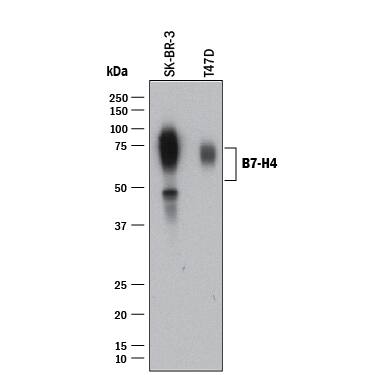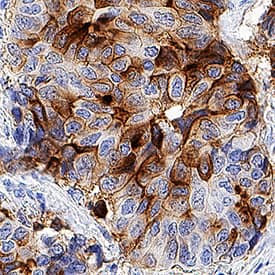Human B7-H4 Antibody
R&D Systems, part of Bio-Techne | Catalog # MAB65764
Recombinant Monoclonal Antibody.


Conjugate
Catalog #
Key Product Details
Species Reactivity
Human
Applications
CyTOF-ready, Flow Cytometry, Immunohistochemistry, Western Blot
Label
Unconjugated
Antibody Source
Recombinant Monoclonal Rabbit IgG Clone # 2318A
Product Specifications
Immunogen
Mouse myeloma cell line, NS0-derived human B7-H4
Phe29-Ser258
Accession # Q7Z7D3
Phe29-Ser258
Accession # Q7Z7D3
Specificity
Detects human B7-H4 in direct ELISAs.
Clonality
Monoclonal
Host
Rabbit
Isotype
IgG
Scientific Data Images for Human B7-H4 Antibody
Detection of human B7‑H4 by Western Blot.
Western blot shows lysates of SK-BR-3 human breast cancer cell line and T47D human breast cancer cell line. PVDF membrane was probed with 1 µg/mL of Rabbit Anti-Human B7-H4 Monoclonal Antibody (Catalog # MAB65764) followed by HRP-conjugated Anti-Rabbit IgG Secondary Antibody (Catalog # HAF008). A specific band was detected for B7-H4 at approximately 50-80 kDa (as indicated). This experiment was conducted under reducing conditions and using Immunoblot Buffer Group 1.Detection of B7-H4 in HEK293 Human Cell Line Transfected with Human B7-H4 and eGFP by Flow Cytometry.
HEK293 human embryonic kidney cell line transfected with human B7-H4 and eGFP was stained with either (A) Rabbit Anti-Human B7-H4 Monoclonal Antibody (Catalog # MAB65764) or (B) Rabbit IgG control antibody (Catalog # MAB1050) followed by APC-conjugated Goat anti-Rabbit IgG Secondary Antibody (Catalog # F0111). View our protocol for Staining Membrane-associated Proteins.B7‑H4 in Human Breast Cancer Tissue.
B7-H4 was detected in immersion fixed paraffin-embedded sections of human breast cancer tissue using Rabbit Anti-Human B7-H4 Monoclonal Antibody (Catalog # MAB65764) at 3 µg/mL for 1 hour at room temperature followed by incubation with the Anti-Rabbit IgG VisUCyte™ HRP Polymer Antibody (Catalog # VC003). Before incubation with the primary antibody, tissue was subjected to heat-induced epitope retrieval using Antigen Retrieval Reagent-Basic (Catalog # CTS013). Tissue was stained using DAB (brown) and counterstained with hematoxylin (blue). Specific staining was localized to cell surfaces in cancer cells. View our protocol for IHC Staining with VisUCyte HRP Polymer Detection Reagents.Applications for Human B7-H4 Antibody
Application
Recommended Usage
CyTOF-ready
Ready to be labeled using established conjugation methods. No BSA or other carrier proteins that could interfere with conjugation.
Flow Cytometry
0.25 µg/106 cells
Sample: HEK293 Human Cell Line Transfected with Human B7-H4 and eGFP
Sample: HEK293 Human Cell Line Transfected with Human B7-H4 and eGFP
Immunohistochemistry
3-25 µg/mL
Sample: Immersion fixed paraffin-embedded sections of human breast cancer tissue
Sample: Immersion fixed paraffin-embedded sections of human breast cancer tissue
Western Blot
1 µg/mL
Sample: SK‑BR‑3 human breast cancer cell line and T47D human breast cancer cell line
Sample: SK‑BR‑3 human breast cancer cell line and T47D human breast cancer cell line
Formulation, Preparation, and Storage
Purification
Protein A or G purified from cell culture supernatant
Reconstitution
Reconstitute at 0.5 mg/mL in sterile PBS. For liquid material, refer to CoA for concentration.
Formulation
Lyophilized from a 0.2 μm filtered solution in PBS with Trehalose. *Small pack size (SP) is supplied either lyophilized or as a 0.2 µm filtered solution in PBS.
Shipping
Lyophilized product is shipped at ambient temperature. Liquid small pack size (-SP) is shipped with polar packs. Upon receipt, store immediately at the temperature recommended below.
Stability & Storage
Use a manual defrost freezer and avoid repeated freeze-thaw cycles.
- 12 months from date of receipt, -20 to -70 °C as supplied.
- 1 month, 2 to 8 °C under sterile conditions after reconstitution.
- 6 months, -20 to -70 °C under sterile conditions after reconstitution.
Background: B7-H4
References
- Yi, K.H. and L. Chen (2009) Immunol. Rev. 229:145.
- Salceda, S. et al. (2005) Exp. Cell Res. 306:128.
- Zang, X. et al. (2003) Proc. Natl. Acad. Sci. 100:10388.
- Prasad, V.R. et al. (2003) Immunity 18:863.
- Sica, G.L. et al. (2003) Immunity 18:849.
- Kryczek, I. et al. (2006) J. Exp. Med. 203:871.
- Tringler, B. et al. (2005) Clin. Cancer Res. 11:1842.
- Xue, Q. et al. (2010) Stem Cells Dev. 19:27.
- Song, H. et al. (2008) Cancer Lett. 266:227.
- Park, G.B. et al. (2009) Immunology 128:360.
- Zang, X. et al. (2007) Proc. Natl. Acad. Sci. 104:19458.
- Krambeck, A.E. et al. (2006) Proc. Natl. Acad. Sci. 103:10391.
- Simon, I. et al. (2006) Cancer Res. 66:1570.
- Thompson, R.H. et al. (2008) Cancer Res. 68:6054.
- Azuma, T. et al. (2009) PloS Med. 6:e1000166.
- Suh, W.-K. et al. (2006) Mol. Cell. Biol. 26:6403.
Long Name
B7 Homolog 4
Alternate Names
B7H4, B7S1, B7x, Vtcn1
Gene Symbol
VTCN1
UniProt
Additional B7-H4 Products
Product Documents for Human B7-H4 Antibody
Product Specific Notices for Human B7-H4 Antibody
For research use only
